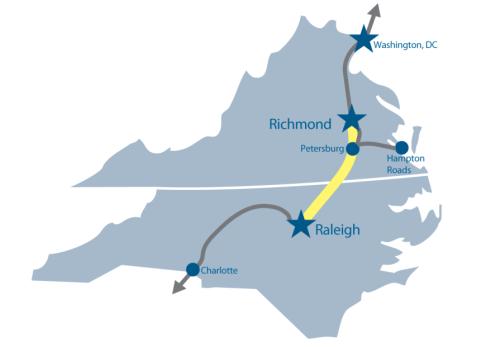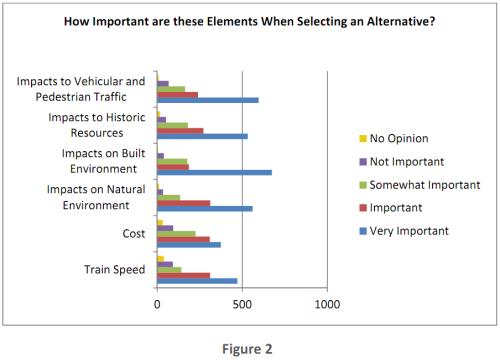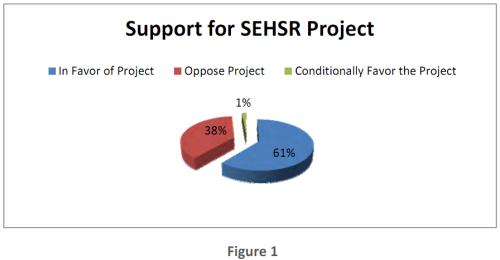
First, let’s start off with the city’s press release:
The North Carolina Department of Transportation (NCDOT) and the Virginia Department of Rail and Public Transportation (DRPT) have released a report recommending to the Federal Railroad Administration (FRA) the preferred rail alternative for each of the 26 sections of the Southeast High Speed Rail (SEHSR) corridor between Richmond, Va. and Raleigh, N.C. (R2R).
The report alternatives are based on considerations concerning the human and natural environment, costs, and operability/constructability. Also considered were the public, local government, and agency comments received following the May 2010 publication of the SEHSR Tier II Draft Environmental Impact Statement (DEIS) for the R2R portion of the SEHSR. Eight public hearings were held in July 2010 to provide information on the alternatives and obtain public input, and several alternatives have been redesigned based on comments received from the public.
Once approved by FRA, the preferred alternatives will be presented in the forthcoming Tier II Final Environmental Impact Statement (FEIS), anticipated to be published in early 2013, followed by a Record of Decision from the FRA and a second round of public hearings.
The SEHSR project proposes to implement approximately 162 miles of high speed rail as part of an overall plan to extend high speed passenger rail service from the Northeast Corridor (Boston, Mass. to Washington, D.C.) southward through Virginia to Charlotte, N.C. and Florida.
The Recommendation Report is available for download on the project website www.sehsr.org.
A lengthy process but another milestone achieved in this plan to better connect North Carolina’s cities to Richmond and points north. For more posts about the Southeast High-Speed Rail project and how it relates to downtown Raleigh, dive into the archives tagged SEHSR.
Looking at the draft recommendation report, there are sections that go over the public hearings that took place starting in 2010 as well as an overview of the comments received. I pulled two of the charts from the report and have them below.

Click on the graphics for a larger view.
There are a couple of interesting points in the second figure. The exact numbers aren’t provided so based on the graph we have:
- The two most important issues to respondents, that is combining the “Important” and “Very Important” response, were Impacts on Built Environment and Impacts on Natural Environment.
- Cost appears to be the least most important element, getting the most “Not Important” responses.
Without deeper surveys, the results can be interpreted in different ways so take it for what it’s worth.
Continuing through, the document then explores each of the twenty-six sections of the route with an overview of alternatives and the final pick of the preferred route for this section. The North Raleigh to Downtown Raleigh piece is the last section mentioned, section V.
The report recommends the NC5 Alternative. We’ve analyzed the NC5 plan back in September 2011 when it was announced. From the document:
The recommended preferred alternative in Section V is Alternative NC5. This decision is based on the fact that it minimizes impacts to neighborhoods, freight operations, and historic resources, and was endorsed by the Raleigh City Council on October 4, 2011. Exhibit 56 shows that NC5 has the least impacts to streams, no residential relocations, fewer business relocations compared to NC3 (but greater than NC1 and NC2), and only one severely impacted noise receptor (compared to 40 for the other alternatives). Additionally, apart from the impact to the historic Raleigh and Gaston Railroad Corridor that is common among all alternatives, Alternative NC5 has no additional impacts to historic resources. Each of the other alternatives (NC1, NC2, and NC3) would have an adverse effect on at least one resource protected under Section 106 of the NHPA, and also require a Section 4(f) use of those properties.
NC5 is also favored by the public. Following the Project Update Meeting, 61 comments were submitted by the public expressing preference for an alternative: three were in favor of NC1 (with no specific reason stated); three were in favor of NC2 (based partially upon cost considerations); three were in favor of NC3 (based upon rail designs, interaction with freight railroads, and downtown connectivity); while 52 expressed a preference for NC5 (based primarily upon minimized impacts to neighborhoods, freight operations, and historic resources).
To see the figures and maps, as well as information on each section, download the report.
Comments
Comments are disabled here. That's because we're all hanging out on the DTRaleigh Community, an online forum for passionate fans of the Oak City.


[…] on the Network today: The Raleigh Connoisseur reports that regional leaders are moving forward with plans for Raleigh to Richmond high-speed […]
Today’s paper: Transit.
He was with his Mayor buddy Fetzer and always will be a thorn in Raleigh BUTT. Paul Coble is a pathetic politician and Raleigh citizen. We do not need your logic/opinion about economic times and taxes. Jobs need to be generated.
A 1/2 cent tax for transit is OUR decision Coble, it will generate job and work needed to start yesterday.
We make the decisions, thus, transit tax should be a referendum this fall.
Coble is clueless, there is a plan, it’s not a concept, it’s been in planning for 20 years or more. Get off oyour high horse or resign. Your the lack of vision in our region. This is an opportunity for people to get back to work. a 1/2 cent tax is nothing. Commissioners need to get their hands out of the cookie jar for their personnal projects and let the citizens of Wake County decide what’s good to us.
Looks like i will be running to remove Coble from his high horse
Agree with Jerry: just announced, Charlooote getting $70M from Obama administration (i guess Obama does not want The Triangle votes – he has lost my vote).
If that awful region of Charloooote can get $70M (to connect Charlooote’s little UNCC universtiy to downtown – are you KIDDING – The Triangles (3) major Universities should already be connected by light rail for student convenience), what is the problem with The Triangle? It’s people like Coble that prevent this region from moving forward. This area is faster growing than Charloooote. A light rail system was needed 10 years ago in our region. The 1/2 cent tax needs to be approved this November before quality of life becomes nothing but windshield time (which in turn means, companies will NOT be attracted to this region)
One of the best ways to win federal dollars towards transit projects is for a city/region to commit itself to transit as well. Charlotte did this when they passed their 1/2 cent sales tax. It’s a better way to give money to an area that is committed to the project.
We too will make a much better case for federal backing if we have shown a commitment to transit and the same 1/2 cent sales tax is the way to do it. By not having this commitment in place, we will not be showing the state and the country that we are serious about transit and therefore they shouldn’t give us the money. This is what happened a few years ago when the New Bern bus corridor was denied funding but a Charlotte bus line was given funding.
It’s not a Charlotte versus Raleigh thing at all, it’s a better gamble in Charlotte. We need to change this around here.
I agree with Leo. Also, who are you going to vote for then, Santorum? Yeah I’m sure he’ll make all our mass transit dreams come true… It’s not like Obama is personally trying to stick it to us. We need a lot more commitment to this at a local level before we can expect the feds to hand out already scarce funds.
To be blunt I will not support any light rail plan that does not have a stop at or very near RDU. I just don’t see the point of all this without it.
Wendell, the light rail plan would include an eventual link to RDU. The airport has said previously that it would build a line from the Metro Center stop (proposed stop at RTP) to the airport, starting with express bus and eventually evolving into a rail link. You’re correct, it would be absurd to exclude RDU from any line.
Wendell, I agree. Transit systems are USELESS without stops at the airport.
For example, think of how USELESS the NYC subway was for its first hundred years from 1904 until 2004 (when Air Train was built). Those trains were just rolling around EMPTY for a century until it finally connected to the airport.
Also, Think of how USELESS BART was before 2003. Think of how USELESS the Chicago L was before 1984.
An Airport link is the only reason that a transit line should be built, and without one, a transit line is USELESS doomed to failure.